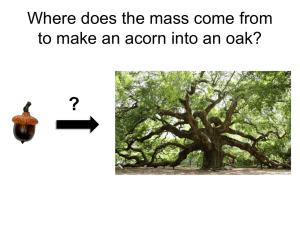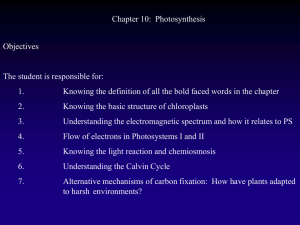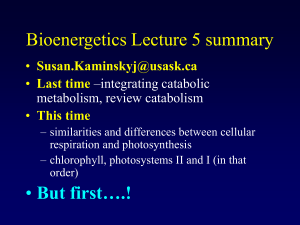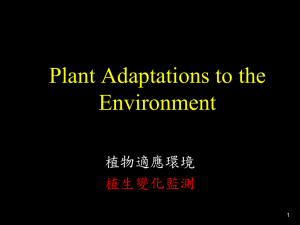Chapter 8: Photosynthesis: Energy from the Sun
advertisement
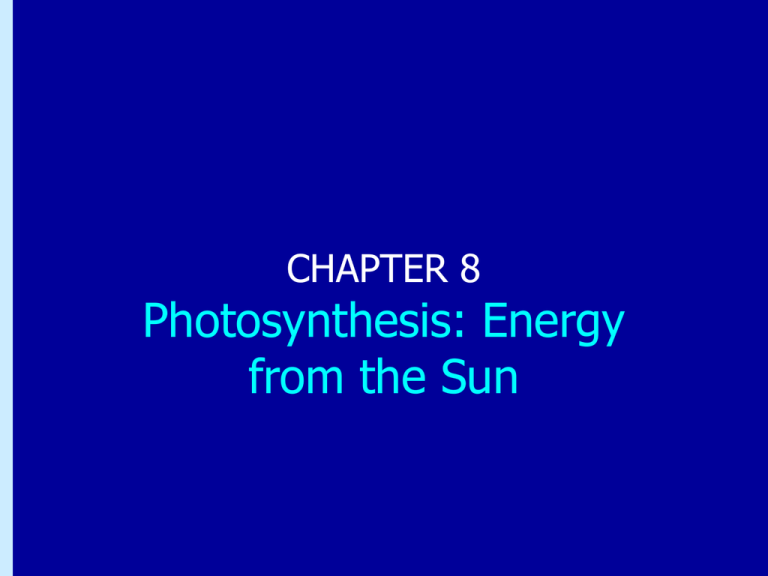
Chapter 8: Photosynthesis: Energy from the Sun CHAPTER 8 Photosynthesis: Energy from the Sun Chapter 8: Photosynthesis: Energy from the Sun Chapter 8: Photosynthesis: Energy from the Sun Photosynthesis Identifying Photosynthetic Reactants and Products The Two Pathways of Photosynthesis: An Overview Properties of Light and Pigments Chapter 8: Photosynthesis: Energy from the Sun Chapter 8: Photosynthesis: Energy from the Sun Light Reactions: Light Absorption Making Sugar from CO2: The Calvin–Benson Cycle Photorespiration and Its Evolutionary Consequences Metabolic Pathways in Plants Chapter 8: Photosynthesis: Energy from the Sun Photosynthesis • Life on Earth depends on the absorption of light energy from the sun. 4 Chapter 8: Photosynthesis: Energy from the Sun Photosynthesis • In plants, photosynthesis takes place in chloroplasts. 5 Chapter 8: Photosynthesis: Energy from the Sun Identifying Photosynthetic Reactants and Products • Photosynthesizing plants take in CO2, water, and light energy, producing O2 and carbohydrate. The overall reaction is 6 CO2 + 12 H2O + light C6H12O6 + 6 O2 + 6 H2O The oxygen atoms in O2 come from water, not from CO2. Review Figures 8.1, 8.2 6 Chapter 8: Photosynthesis: Energy from the Sun Figure 8.1 Figure 8.1 figure 08-01.jpg Chapter 8: Photosynthesis: Energy from the Sun Figure 8.2 Figure 8.2 figure 08-02.jpg Chapter 8: Photosynthesis: Energy from the Sun The Two Pathways of Photosynthesis: An Overview • In the light reactions of photosynthesis, electron flow and photophosphorylation produce ATP and reduce NADP+ to NADPH + H+. Review Figure 8.3 9 Chapter 8: Photosynthesis: Energy from the Sun Figure 8.3 Figure 8.3 figure 08-03.jpg Chapter 8: Photosynthesis: Energy from the Sun The Two Pathways of Photosynthesis: An Overview • ATP and NADPH + H+ are needed for the reactions that fix and reduce CO2 in the Calvin–Benson cycle, forming sugars. Review Figure 8.3 11 Chapter 8: Photosynthesis: Energy from the Sun Figure 8.3 Figure 8.3 figure 08-03.jpg Chapter 8: Photosynthesis: Energy from the Sun Properties of Light and Pigments • Light energy comes in packets called photons, but it also has wavelike properties. Review Figure 8.4 12 Chapter 8: Photosynthesis: Energy from the Sun Figure 8.4 Figure 8.4 figure 08-04.jpg Chapter 8: Photosynthesis: Energy from the Sun Properties of Light and Pigments • Pigments absorb light in the visible spectrum. Review Figure 8.5 14 Chapter 8: Photosynthesis: Energy from the Sun Figure 8.5 Figure 8.5 figure 08-05.jpg Chapter 8: Photosynthesis: Energy from the Sun Properties of Light and Pigments • Absorption of a photon puts a pigment molecule in an excited state with more energy than its ground state. Review Figure 8.6 16 Chapter 8: Photosynthesis: Energy from the Sun Figure 8.6 Figure 8.6 figure 08-06.jpg Chapter 8: Photosynthesis: Energy from the Sun Properties of Light and Pigments • Each compound has a characteristic absorption spectrum which reveals the biological effectiveness of different wavelengths of light. Review Figures 8.7, 8.8 18 Chapter 8: Photosynthesis: Energy from the Sun Figure 8.7 Figure 8.7 figure 08-07.jpg Chapter 8: Photosynthesis: Energy from the Sun Figure 8.8 Figure 8.8 figure 08-08.jpg Chapter 8: Photosynthesis: Energy from the Sun Properties of Light and Pigments • Chlorophylls and accessory pigments form antenna systems for absorption of light energy. Review Figures 8.7, 8.9, 8.11 21 Chapter 8: Photosynthesis: Energy from the Sun Figure 8.9 Figure 8.9 figure 08-09.jpg Chapter 8: Photosynthesis: Energy from the Sun Light Reactions: Light Absorption • An excited pigment molecule may lose its energy by fluorescence, or by transferring it to another pigment molecule. Review Figures 8.10, 8.11 24 Chapter 8: Photosynthesis: Energy from the Sun Figure 8.10 Figure 8.10 figure 08-10.jpg Chapter 8: Photosynthesis: Energy from the Sun Figure 8.11 Figure 8.11 figure 08-11.jpg Chapter 8: Photosynthesis: Energy from the Sun Electron Flow, Photophosphorylation, and Reductions • Noncyclic electron flow uses two photosystems: • Photosystem II uses P680 chlorophyll, from which light-excited electrons pass to a redox chain that drives chemiosmotic ATP production. Light-driven water oxidation releases O2, passing electrons to P680 chlorophyll. • Photosystem I passes electrons from P700 chlorophyll to another redox chain and then to NADP+, forming NADPH + H+. Review Figure 8.12 26 Chapter 8: Photosynthesis: Energy from the Sun Figure 8.12 – Part 1 Figure 8.12 – Part 1 figure 08-12a.jpg Chapter 8: Photosynthesis: Energy from the Sun Figure 8.12 – Part 2 Figure 8.12 – Part 2 figure 08-12b.jpg Chapter 8: Photosynthesis: Energy from the Sun Electron Flow, Photophosphorylation, and Reductions • Cyclic electron flow uses P700 chlorophyll producing only ATP. • Its operation maintains the proper balance of ATP and NADPH + H+ in the chloroplast. Review Figure 8.13 29 Chapter 8: Photosynthesis: Energy from the Sun Figure 8.13 Figure 8.13 figure 08-13.jpg Chapter 8: Photosynthesis: Energy from the Sun Electron Flow, Photophosphorylation, and Reductions • Chemiosmosis is the source of ATP in photophosphorylation. • Electron transport pumps protons from stroma into thylakoids, establishing a proton-motive force. • Proton diffusion to stroma via ATP synthase channels drives ATP formation from ADP and Pi. Review Figure 8.14 31 Chapter 8: Photosynthesis: Energy from the Sun Figure 8.14 Figure 8.14 figure 08-14.jpg Chapter 8: Photosynthesis: Energy from the Sun Electron Flow, Photophosphorylation, and Reductions • Photosynthesis probably originated in anaerobic bacteria that used H2S as a source of electrons instead of H2O. • Oxygen production by bacteria was important in eukaryote evolution. 33 Chapter 8: Photosynthesis: Energy from the Sun Light-Dependent Reactions Chapter 8: Photosynthesis: Energy from the Sun Photosynthesis begins when pigments in photosystem II absorb light, increasing their energy level. Photosystem II Chapter 8: Photosynthesis: Energy from the Sun These high-energy electrons are passed on to the electron transport chain. Photosystem II High-energy electron Electron carriers Chapter 8: Photosynthesis: Energy from the Sun Enzymes on the thylakoid membrane break water molecules into: Photosystem II 2H2O High-energy electron Electron carriers Chapter 8: Photosynthesis: Energy from the Sun hydrogen ions oxygen atoms energized electrons Photosystem II + O2 2H2O High-energy electron Electron carriers Chapter 8: Photosynthesis: Energy from the Sun The energized electrons from water replace the high-energy electrons that chlorophyll lost to the electron transport chain. Photosystem II + 2H2O High-energy electron O2 Chapter 8: Photosynthesis: Energy from the Sun As plants remove electrons from water, oxygen is left behind and is released into the air. Photosystem II + 2H2O High-energy electron O2 Chapter 8: Photosynthesis: Energy from the Sun The hydrogen ions left behind when water is broken apart are released inside the thylakoid membrane. Photosystem II + 2H2O High-energy electron O2 Chapter 8: Photosynthesis: Energy from the Sun Energy from the electrons is used to transport H+ ions from the stroma into the inner thylakoid space. Photosystem II + 2H2O O2 Chapter 8: Photosynthesis: Energy from the Sun High-energy electrons move through the electron transport chain from photosystem II to photosystem I. Photosystem II + O2 2H2O Photosystem I Chapter 8: Photosynthesis: Energy from the Sun Pigments in photosystem I use energy from light to re-energize the electrons. + O2 2H2O Photosystem I Chapter 8: Photosynthesis: Energy from the Sun NADP+ then picks up these highenergy electrons, along with H+ ions, and becomes NADPH. • + O2 2H2O 2 NADP+ 2 2 NADPH Chapter 8: Photosynthesis: Energy from the Sun As electrons are passed from chlorophyll to NADP+, more H+ ions are pumped across the membrane. + O2 2H2O 2 NADP+ 2 2 NADPH Chapter 8: Photosynthesis: Energy from the Sun Soon, the inside of the membrane fills up with positively charged hydrogen ions, which makes the outside of the membrane negatively charged. + O2 2H2O 2 NADP+ 2 2 NADPH Chapter 8: Photosynthesis: Energy from the Sun The difference in charges across the membrane provides the energy to make ATP + O2 2H2O 2 NADP+ 2 2 NADPH Chapter 8: Photosynthesis: Energy from the Sun H+ ions cannot cross the membrane directly. ATP synthase + O2 2H2O 2 NADP+ 2 2 NADPH Chapter 8: Photosynthesis: Energy from the Sun The cell membrane contains a protein called ATP synthase that allows H+ ions to pass through it ATP synthase + O2 2H2O 2 NADP+ 2 2 NADPH Chapter 8: Photosynthesis: Energy from the Sun As H+ ions pass through ATP synthase, the protein rotates. ATP synthase + O2 2H2O 2 NADP+ 2 2 NADPH Chapter 8: Photosynthesis: Energy from the Sun As it rotates, ATP synthase binds ADP and a phosphate group together to produce ATP. ATP synthase + O2 2H2O ADP 2 NADP+ 2 2 NADPH Chapter 8: Photosynthesis: Energy from the Sun Because of this system, light-dependent electron transport produces not only highenergy electrons but ATP as well. ATP synthase + O2 2H2O ADP 2 NADP+ 2 2 NADPH Chapter 8: Photosynthesis: Energy from the Sun Making Sugar from CO2: The Calvin–Benson Cycle • The Calvin–Benson cycle makes sugar from CO2. • This pathway was elucidated through use of radioactive tracers. Review Figure 8.15 34 Chapter 8: Photosynthesis: Energy from the Sun Figure 8.15 Figure 8.15 figure 08-15.jpg Chapter 8: Photosynthesis: Energy from the Sun Making Sugar from CO2: The Calvin–Benson Cycle • The Calvin–Benson cycle has three phases: fixation of CO2, reduction and carbohydrate production, and regeneration of RuBP. • RuBP is the initial CO2 acceptor, 3PG is the first stable product of CO2 fixation. • Rubisco catalyzes the reaction of CO2 and RuBP to form 3PG. Review Figures 8.16, 8.17 36 Chapter 8: Photosynthesis: Energy from the Sun Figure 8.16 Figure 8.16 figure 08-16.jpg Chapter 8: Photosynthesis: Energy from the Sun Figure 8.17 Figure 8.17 figure 08-17.jpg Chapter 8: Photosynthesis: Energy from the Sun Photorespiration and Its Evolutionary Consequences • Rubisco catalyzes a reaction between O2 and RuBP in addition to that of CO2 and RuBP. • Photorespiration significantly reduces photosynthesis efficiency. • Reactions that constitute photorespiration are distributed over chloroplast, peroxisome, and mitochondria organelles. 39 Chapter 8: Photosynthesis: Energy from the Sun Photorespiration and Its Evolutionary Consequences • At high temperatures and low CO2 concentrations, the oxygenase function of rubisco is favored. 40 Chapter 8: Photosynthesis: Energy from the Sun Photorespiration and Its Evolutionary Consequences • C4 plants bypass photorespiration. • PEP carboxylase in mesophyll chloroplasts initially fixes CO2 in four-carbon acids, which diffuse into bundle sheath cells, where their decarboxylation produces locally high concentrations of CO2. Review Figures 8.19 41 Chapter 8: Photosynthesis: Energy from the Sun Figure 8.19 Figure 8.19 figure 08-19.jpg Chapter 8: Photosynthesis: Energy from the Sun Photorespiration and Its Evolutionary Consequences • CAM plants operate much like C4 plants, but their initial CO2 fixation by PEP carboxylase is temporally separated from the Calvin– Benson cycle, rather than spatially separated. Review Figure 8.21 43 Chapter 8: Photosynthesis: Energy from the Sun Figure 8.21 Figure 8.21 figure 08-21.jpg Chapter 8: Photosynthesis: Energy from the Sun Metabolic Pathways in Plants • Plants respire in light and darkness, but photosynthesize only in light. • A plant must photosynthesize more than it respires, giving it a net gain of reduced energy-rich compounds. 45 Chapter 8: Photosynthesis: Energy from the Sun Metabolic Pathways in Plants • Photosynthesis and respiration are linked through the Calvin–Benson cycle, the citric acid cycle, and glycolysis. Review Figure 8.22 46 Chapter 8: Photosynthesis: Energy from the Sun Figure 8.22 – Part 1 Figure 8.22 – Part 1 figure 08-22a.jpg Chapter 8: Photosynthesis: Energy from the Sun Figure 8.22 – Part 2 Figure 8.22 – Part 2 figure 08-22b.jpg




